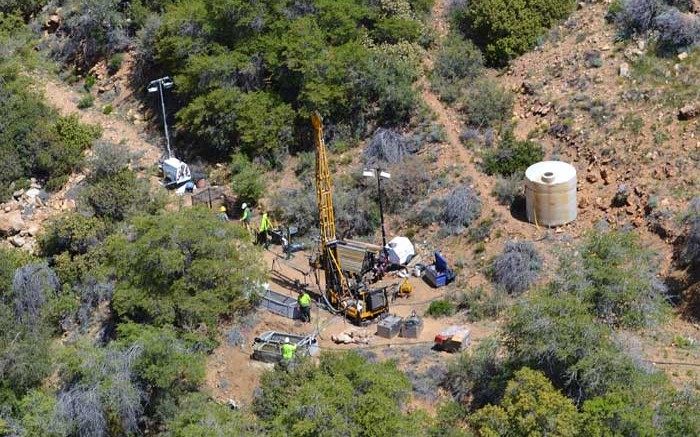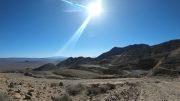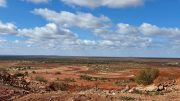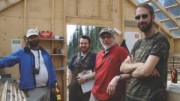PHOENIX, ARIZONA — “Here we are, in the middle of one of the most productive copper districts in the world — Arizona — and we were able to just stake this ground,” says David Cole, president and CEO of Eurasian Minerals (TSXV: EMX). “Outcropping ore-grade mineralization, and we just staked it.”
Cole utters these words as we clamber around Eurasian’s Copper Basin project, a land package 80 km north of Phoenix. The rocks at Copper Basin back up his talk, with chalcopyrite, molybdenite and malachite clearly visible in outcrops.
The project is located in the U.S. and is fairly accessible, and surrounded by a relatively supportive jurisdiction.
Why, then, was the land available?
It boils down to one reason: geologists thought they understood Arizona’s rocks, and, based on the accepted model of porphyry zonation, had decided there was no economic copper in the area.
But there is copper, and the reason for the too-hasty writeoff of the region’s potential is that the geologists had assumed the rocks in that part of the earth’s crust had stayed upright — when in fact, they did no such thing.
During the Mid-Tertiary Extension some 30 million years ago, the crust in what is now Arizona — and the copper deposits in it — was torn apart, and the chunks thus created were twisted, turned, tilted and scattered.
The result: porphyry bodies that once existed as vertical carrot-shaped structures within the crust were tilted over, sliced into chunks and spread out. In some places the chunks stayed fairly close together, resulting in fairly intact porphyries lying at an angle underneath younger cover. In other places, dramatic crustal extension has spread the slices out horizontally.
Geologists expected porphyries to be upright because of a landmark paper in 1970 by David Lowell and John Guilbert, who helped decipher the porphyry code and explain porphyry zonation. They described porphyries as tubular bodies extending up through the crust, made up of shells of different types of alteration and mineralization.
The Lowell-Guilbert porphyry copper model quickly became the go-to tool for finding copper.
“When the Lowell and Guilbert model came out it took the zones that you see in porphyries and made sense of them, so much so that the end result was a bull’s eye: a geologist could walk across the surface, map the alteration and know exactly where to drill to make a discovery,” says David Johnson, Eurasian’s chief geologist. “We were very successful — in some ways too successful — in taking that model and using it everywhere in the world.”
As Johnson explains, the model is good at directing drills to the sweet spot of a conventional upright porphyry. If a porphyry is tipped over, however, geologists have to think sideways — but in Arizona, a series of events in the late 1970s meant that just didn’t happen.
“The price of copper went down, all these exploration offices were shut down, and lots of geos left the porphyry copper field to work on Carlin-style stuff up in Nevada,” Johnson says. Around the same time, the easy Arizona discoveries started to dry up: the outcropping deposits had been found, forcing explorers to look for mineralization under cover.
“You can talk to many of the exploration VPs working here at that time, and they will tell you they spent millions of dollars on geophysical techniques to try to find these deposits under cover,” Johnson says. “They had some success, but not a lot — because they didn’t yet understand the tilting and how fragmented the rocks were.”
Johnson points to one instance after another of companies drilling straight down into a geophysical target and missing, likely because tilting and extension had displaced the mineralized body.
“One of the neat things here is that you walk around and see a dyke swarm with quartz-sericite-pyrite alteration, which if you’re a geologists gets you all excited because it means you’re at the top of a copper porphyry system,” Johnson says. “So you say, ‘Alright, let’s drill down right here’ — but if the system is tilted, what happens? You miss, because the deposit is actually over to the side, not below, and so you end up drilling out through the side of the system. And that happened all over Arizona.”
The failure of classic geological and geophysical models to reveal Arizona’s copper secrets stuck. Copper exploration in the region declined significantly, at least until the mid-1990s, when a major copper discovery named Resolution reignited interest in the state.
Resolution has since grown to become the largest copper deposit in the U.S., and one of the largest in the world. It is currently under development as an underground mine by Resolution Copper Mining, which is held by Rio Tinto (NYSE: RIO) (55%) and BHP Billiton (NYSE: BHP). Resolution is home to 1.7 billion inferred tonnes grading of 1.52% copper and 0.035% molybdenum. The mine will produce 1 billion lb. copper per year for decades.
It’s a phenomenal deposit, and it’s in good company: Arizona is one of the top-five porphyry districts in the world in terms of copper produced, and Resolution is surrounded by massive copper mines. In fact, for the mines in the Globe-Miami district southeast of Phoenix, the combination of output from the last hundred years and reserves still in the ground totals some 17 million tonnes of copper.
But Johnson and the Eurasian team think there are millions of tonnes of copper still waiting to be discovered — because not many geologists have thought about the region’s rocks from the right angle yet.
Arizona portfolio
Eurasian has a lot of regional rocks to assess from this new perspective. The company holds more than 170 sq. km land in Arizona, spread across 15 projects.
Much of Eurasian’s work at these sites is based on interpretation of the region’s structural geology: that the crust was pulled apart and the resulting pieces, some of which were chunks of porphyries, didn’t stay put. They fell onto their sides, were buried by sediments, were broken apart again by younger faults and over millions of years migrated away from the other chunks of rock that used to be their neighbours.
The end result is different for the three areas where many of Eurasian’s projects are clustered. One cluster lies 80 km north of Phoenix, anchored by Eurasian’s most advanced Arizona prospect: Copper Basin. This area likely saw a fair bit of tilting — Eurasian thinks the formerly upright porphyries near Copper Basin are now tilted more than 65 degrees, with tops pointing to the east — but with less extension than other parts of Arizona.
Eurasian’s second cluster of projects sits southeast of Phoenix, in the Globe-Miami copper district. Here the tilting and dismemberment were far more drastic. Porphyries that formed as vertical pipes are now lying on their sides, likely tilted a full 90 degrees west. The original systems have also been seriously stretched, with chunks littered along corridors four times longer than the original porphyries were tall.
The third cluster is in the Pioneer Mining district, which is next door to Globe-Miami — though proximity doesn’t mean Pioneer and Globe-Miami are similar. Instead, the two regions headed in opposite directions. While the rocks in Globe-Miami tilted and stretch
ed westward, Johnson’s team believes the deposits and host rocks in Pioneer are tilted 40 degrees east. And Pioneer did not undergo the 400% extension that took place in Globe-Miami, instead seeing only limited extension.
The differences mean each area demands unique exploration tactics.
Sliced-up carrots
“People are getting comfortable doing much of their exploration for porphyries from their desktop computers,” Johnson says. “The nice thing about porphyries is that they’re big systems, so they do make big geophysical features. And in a lot of places that works — you can fly over the Andes in a plane, collect the data, see the anomalies, go down on the ground, verify with geochemistry and you’ll end up with a pretty good idea of what the system looks like. But here, where everything has been chopped up, dismembered, turned over on its side and is underneath cover — it’s a different game. There are companies that have spent years running geophysical surveys of the area and not really understanding the results.”
Johnson and the geologists from the University of Arizona who applied the tilting and extension concept believe that, in the Globe-Miami area, the crust has been pulled into chunks and extended 400%. That means a porphyry that pushed up through the crust 50 to 60 million years ago looks little like a porphyry now.
“One system that was originally about 3 km in vertical extent is now spread over 15 km of horizontal extent, in discrete pieces,” Johnson says. “So you’ve got multiple targets — all the pieces of the sliced-up carrot.”
The question is: Have all the slices been found?
To answer that question, Eurasian’s key exploration tactic in this district is to rebuild each porphyry centre, modelling the dismemberment and extension in reverse. And in many cases, they believe the answer is “no.”
There are three porphyry trends to reconstruct in the Globe-Miami district. The three systems all strike northeast, the direction of the Mid-Tertiary Extension that created the trends when it pulled apart three neighbouring porphyries.
Copper Springs — the southernmost trend — is host to Eurasian’s Copper Springs project. Eurasian staked the ground after reconstructing the sliced-up and scattered porphyry that created the trend. That effort revealed that a large chunk of prime mineralization remains unaccounted for — and since these multi-million tonne chunks of rock cannot simply disappear, it has to be sitting in between two other known chunks. Naturally, Eurasian’s property covers the ground where Johnson surmises the missing porphyry piece has to be.
Similarly, the Jasper Canyon project covers the eastern end of the Pinto Valley porphyry trend, which is the northernmost trend in Globe-Miami. Geologists have discovered more than 5 million tonnes of copper from mines along this trend, from Pinto Valley in the southwest to Copper Cities in the northeast.
Eurasian believes the Pinto Valley trend holds another big porphyry chunk that has yet to be found, at its eastern end. So that is where the company staked ground.
Such is Eurasian’s method in this part of Arizona — seeking missing porphyry chunks. For Johnson, advancing these theories in Arizona is particularly intriguing, since he studied at the University of Arizona. With its dozen mines, the nearby Globe-Miami and surrounding districts are a playground for Arizona’s geology students — but one that, for Johnson, created more questions than answers.
“As a graduate student, I had the opportunity to tour many of Arizona’s copper mines,” Johnson says. “I clearly remember talking to mine geologists and looking at their cross-sections, which showed everything as being upright. Yet then there are these young rocks, significantly younger than the mineralized phase, sitting at the edge of the pit, and they’re tilted.
“If the young rocks are tilted, everything below has to be tilted too,” he says. “That resonated with me.”
Now he is getting the chance to explore this hypothesis, and as evidence supporting the tilting-and-extension concept mounts, Johnson and his team are excited about what the next phases of exploration might bring.
“We’ve got systems on our properties where we know where the top of the porphyry is and we know where the bottom is, so it’s sort of like shooting fish in a barrel,” he says. “The good zone has to be somewhere in-between.”
Pioneer targets
“The Pioneer district is world-class,” Johnson says. “We have three projects in the area that we think, based on our understanding of the geology and what’s actually going on, are pretty obvious targets — at least from a conceptual standpoint.”
These three projects are Superior West, Copper King and Red Top.
Superior West is just west of Resolution. Eurasian staked the adjacent ground on the hunch that Resolution may be one of a cluster of porphyries, the others of which are still hidden.
When Resolution starts producing it will not be the first copper pulled from those rocks. The Magma vein was mined by Magma Copper up to 1996, during which time it produced 26 million tons of ore grading more than 4% copper, along with silver and gold.
Veins of this sort are thought to vector into porphyries, so it was long assumed that the Magma vein vectored into the Resolution deposit. However, Eurasian’s interpretation of published studies suggests that the Magma vein vectors away from Resolution, to the west — straight onto the Superior West property.
That suggests that a concealed porphyry copper system exists on Eurasian’s ground, potentially a large one. And there’s a second exploration target on the property: the high-grade Magma vein was displaced by a fault as it headed west, and the offset western extension has never been found.
This double potential at Superior West has attracted a joint-venture partner. Freeport- McMoRan Copper & Gold (NYSE: FCX) is earning an initial 51% stake in the property by spending $4.5 million over five years, after which it will have the option to boost its stake 70% by completing a feasibility study and making a cash payment.
Eurasian’s other two properties in the Pioneer district are Copper King and Red Top — two early-stage targets acquired in 2012. In Pioneer, Eurasian interprets that 30 million years of tilting has left the region’s rocks at a 40-degree angle, with their tops pointing east. The region saw far little dismemberment, so Eurasian’s concept at Copper King is that the economic part of a tilted porphyry now sits below surface, covered by less altered rocks.
Surface showings abound, in the form of porphyry dykes and quartz-sulphide veins with potassic and sericitic alteration, as well as calc-silicate alteration with associated copper mineralization in carbonate host rocks. These surface showings extend along a kilometre of strike and they demonstrate precisely the base metal zoning that a tilted porphyry should show. If it exists, the porphyry remained undiscovered, because anyone who drilled straight down from surface showings would likely have missed the tilted system.
Copper King sits just northeast of Superior West. Red Top is 2 km north of Copper King and based on the same premise — that a tilted porphyry lies adjacent to altered surface outcrops, this time containing advanced
argillic alteration, but hidden beneath much less altered rocks.
Kilometres of core
Eurasian’s third cluster of Arizona targets is north of Phoenix and home to Copper Basin.
Previous operators drilled 10 shallow and five deep holes at Copper Basin. The work confirmed porphyry-style copper-moly mineralization over a small area — but one of the deep holes returned an interesting result: 0.2% copper and 0.025% moly over 940 metres.
That near-kilometre of porphyry might be just the tip of the iceberg.
“A kilometre of porphyry is great, but when you’re drilling into a porphyry that’s tilted, one hole doesn’t give you any idea how big it actually is,” Johnson says. “Did the hole cut through the middle of the body? Or did it just graze the side?”
The property hadn’t seen a drill since that early 1970s effort, but Eurasian started mapping and surveying as soon as it staked the open ground in 2010. Alteration zonation patterns combined with magnetics data suggest a porphyry system tilted on its side, with its top pointed east.
Based on this model, Eurasian completed a seven-hole drill program in the first half of 2013. The results, which recently came out, are promising.
All seven holes were collared in mineralization and six of the seven holes bottomed in copper-moly mineralization. The first hole, intended to verify that deep historic hit, similarly bore alteration and mineralization along its entire length. The hole’s 920 metres of core graded 0.18% copper and 0.029% moly, starting from surface and including several higher-grade sub-intervals, such as 34 metres of 0.35% copper and 0.017% moly, and 104 metres of 0.21% copper and 0.039% moly.
Hole 1 was collared near the middle of the target zone as defined by surface mineralization. Hole 2 was drilled a few hundred metres west and also hit into porphyry mineralization, returning 0.19% copper and 0.019% moly over 378 metres, starting from surface and including 94 metres of 0.3% copper.
Nearby, hole 6 produced a similar intercept: 305 metres of 0.13% copper and 0.019% moly. Hole 7, collared a few hundred metres south, hit into 311 metres of 0.17% copper and 0.016% moly.
It seems there is indeed a porphyry at Copper Basin. But how big is it? If alteration patterns and widespread, iron-rich boulders are any indication, the answer might be: large.
To start, mapping shows porphyry-style alteration and mineralization spread over 1.5 sq. km, while the magnetics survey shows a mag-low anomaly reaching more than a kilometre in depth. In addition, the alteration zoning patterns and the mag low’s extension to the northeast suggests the system continues in that direction, underneath less altered rocks peripheral to the exposed target area.
Then there are the boulders.
When groundwater passes through metal-rich sulphide rocks, like those in the target zone of a porphyry, it becomes acidic and laden with metals, specifically iron and manganese oxides and hydroxides. When the water exits the rocks, the metals precipitate. The results are ferricrete and manganocrete — concrete-like substances comprised of cemented alluvial material hardened into conglomerate boulders.
“Geologists exploring for porphyries get excited when they see ferricrete and manganocrete,” Cole says. And there is ferricrete and manganocrete all over Copper Basin. The iron boulders are spread out over a large area, suggesting the hidden porphyry could be sizeable.
These bits of information already had Eurasian intrigued when, late in 2010, a fortuitous sequence of events revealed new evidence.
The property is fairly steep and a wildfire a few years earlier had killed many of the trees, destabilizing the soil. Then a winter of particularly heavy rains set off a large debris flow. A wall of mud, trees and rocks came crashing down the hillside.
No one from Eurasian saw the debris flow itself, but when staff arrived on the property in the spring they were greeted by a wall of freshly exposed bedrock covered with huge green streaks. Turns out that in the area of the debris flow, the alluvial fill that used to overlie the basement formation had all been scraped away — and the basement in that area is copper-moly-laced porphyry.
It provided a glimpse into the system, and the team liked what they saw.
“Our mapping indicates a dynamic system involving reversals — we see lots of instances of high-temperature mineral assemblages cutting lower-temperature assemblages,” Cole says. “That shows there were multiple phases of mineralization, which is something we like to see in porphyry systems because it means it was a wild Saturday night. And that is what you need to develop a large deposit.”
The surface showings, the iron-rich boulders, the historic drill data and Eurasian’s mapping efforts were enough to secure a solid joint-venture partner at Copper Basin. Vale (NYSE: VALE), through its subsidiary Vale Exploration USA, has to spend US$4.5 million over four years and reimburse Eurasian’s expenses to date to earn a 60% stake in the property. After that the major can increase its stake to 75% by spending at least US$1 million a year and producing a feasibility study prior to 2022.
Business model
Eurasian is a true prospect-generator. The company focuses on finding prospective ground in underexplored areas, completing enough initial exploration work to demonstrate a project’s potential and finding a joint-venture partner willing to fund further work in exchange for a stake.
Sticking to this model means that Eurasian has a portfolio of some 60 projects spread across the globe, including Turkey, Scandinavia, Haiti, Australia and New Zealand. At most of these sites, exploration work is being financed by OPM, or “Other People’s Money.”
It’s a common term in the exploration sector, but Eurasian has proven itself adept at not just finding willing partners for its projects, but inking favourable deals. For instance, Eurasian’s deal with Vale for Copper Basin is built so that Vale does not own any part of the project until it completes all of the requirements for its 60% earn-in.
The Vale deal is fairly representative of Eurasian’s other joint-venture agreements. In negotiating such deals, Eurasian tries to: maintain ownership and operatorship until the partner clears several hurdles; have its acquisition and exploration costs reimbursed; and include a royalty or cash-payment requirement if the project reaches production.
In this sense, the company’s Arizona projects are a lot like the rest of its portfolio: they’re in a region that is underexplored and the company has — or is searching for — partners for all of its properties.
“There are few groups exploring this part of the world and thinking about it in this manner,” Johnson says. “We think that has led to a lot of low-hanging fruit.”
In each area where it works, Eurasian faces different challenges in finding partners, such as convincing Newmont Mining (TSX: NMC; NYSE: NEM) that Haiti — where the major has taken over several gold projects — was a good bet. In Arizona, the task has been to get potential partners to believe in its new geological concepts.
“With our business model where we partner everything, one of the challenges has been convincing other groups of the opportunity,” Johnson says. “They don’t b
elieve the ground is open, or was open, and it’s understandable — in any other part of the world this ground wouldn’t be open, you couldn’t go up beside a world-class deposit like Resolution and stake ground. Here you can.”
So far, few have followed in Eurasian’s footsteps. As such there are opportunities today to stake new targets in Arizona, for those with faith in this new geological paradigm for an old copper district.
Eurasian has more than $20 million in the bank. The company’s shares have recently recovered from a 52-week low of just above $1 to sit near $1.30. Last October they were worth $2.50.
Eurasian has 72 million shares outstanding, 88 million fully diluted.





Be the first to comment on "Eurasian rethinks Arizona’s copper riches"